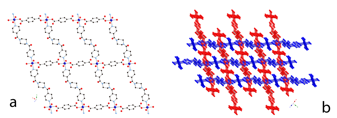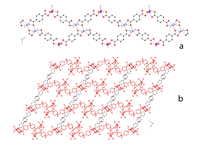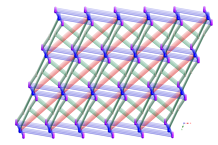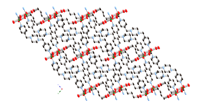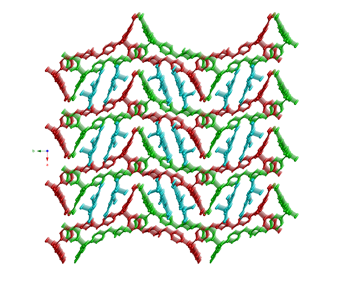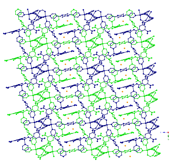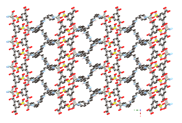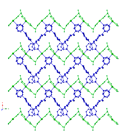www.acsprf.org
Reports: B348311-B3: Synthesis, Structural Determination, and Physicochemical Property Studies of Novel Coordination Polymers Incorporating Kinked and Hydrogen-Bonding Capable Bifunctional Organodiimines
Robert L. LaDuca , Michigan State University
Over the past year the undergraduate-only LaDuca research group has explored the synthesis, structural characterization, and physical property investigation of divalent metal dicarboxylate coordination polymers containing hydrogen-bonding capable and flexible tethering dipyridyl ligands.
During the timeframe September 2010 to August 2011, the group published 26 articles. Five of the papers were published in flagship ACS journals Inorganic Chemistry and Crystal Growth & Design; three others were published in the important RSC journal CrystEngComm. Stipends for a highly talented female undergraduate researcher Amy Pochodylo were covered by the grant. She was recently awarded a most prestigious Goldwater Scholarship largely because of her sterling and prodigious research output. Six other students worked on this project as part of independent study courses, with supplies and analysis costs borne by the grant. Five of these students were female; one of these women is African-American (Lestella Bell). Laura Sposato, a previous undergraduate researcher in the group, has just entered the Ph. D. Program in Chemistry at Berkeley with intent to pursue dissertation research in inorganic materials. Curtis Wang, who worked in the group as a High School honors student and earned first authorship on recent Inorganic Chemistry article, was awarded Intel Science Talent Search Semi-Finalist status.
The undergraduates were deeply and independently involved in every aspect of the work: organic synthesis of the dipyridyl ligands, low- and high-temperature inorganic synthesis, single crystal X-ray crystallography, molecular graphics rendering, variable temperature magnetic susceptibility studies, fluorescence spectroscopy, and thermogravimetric analysis. In particular, Amy Pochodylo played a major role in manuscript preparation, including solo writing of two papers that were published in Elsevier journals. It is clearly evident that all students developed laboratory and analysis techniques during their time in the research laboratory. Perhaps more importantly, they developed these capabilities while investigating new science, not well-worn procedures.
The PI does not host any graduate students or postdoctoral fellows, because of his unique appointment within Lyman Briggs College at Michigan State University (an under-graduate-only residential college for the study of science and its impact on society). Thus the advancement of his research program depends critically on the hard work of these undergraduates.
Much of the research carried out in the 2010-2011 reporting period involved the synthesis, structural characterization, and physical property measurements of divalent metal coordination polymers incorporating the seldom-used long-spanning and hydrogen-bonding capable dipyridyl ligands bis(4-pyridylmethyl)piperazine (bpmp) and bis(4-pyridylformyl)piperazine (bpfp). The hydrogen-bonding and ligating ability of the formyl groups in bpfp, along with its ability to adopt cis and trans formyl group conformations, has led to dramatic differences in coordination polymer dimensionality and topology. It is not possible to present all of the group's results for the year in this limited space, so only highlights from higher impact journal publications will be given.
Perhaps the most striking results from our group during the reporting period involved divalent metal 1,4-benzenedicarboxylate (tere) coordination polymers containing bpfp, which were reported recently in Inorganic Chemistry. These materials show diverse 2D interpenetrated, 3D self-penetrated, or 1D polyrotaxane topologies. {[Zn(tere)(bpfp) (H2O)2]¥4H2O}n (1) exhibits mutually inclined 2D + 2D ˆ 3D interpenetration of layers. {[Cd4(tere)4(bpfp)3(H2O)2]¥8H2O}n (2) possesses a complicated trinodal self-penetrated network. [Zn2Cl2(tere)(bpfp)2]n (3) is the first example of a 1D + 1D ˆ 1D polyrotaxane coordination polymer. Metal coordination geometry plays a crucial role in dictating the overall dimensionality in this system.
|
1
|
|
2
|
|
3
|
Hydrothermal reaction of divalent metal precursors, the conformationally flexible straight chain adipic acid and bpmp resulted in generation of a series of coordination polymers whose 2D and three-dimensional 3D topologies depend on coordination environment, adipate conformation, anion occlusion and carboxylate binding mode. {[Cd(adipate) (H2bpmp)(H2O)]SO4¥4H2O}n manifests simple (4,4) grid cationic layers, while its oxoanion-free congener [Cd(adipate)(bpmp)]n has a 5-fold interpenetrated diamondoid lattice. {[Cu(adipate)(Hbpmp)(H2O)]ClO4¥3H2O}n displays {Cu2O2} dimer-based (4,4) grid cationic layers. The isostructural complexes [M(adipate)(bpmp)(H2O)]n (M = Co, 4; M = Ni, 5) possess anti-syn bridged 1-D [M(OCO)]n chains and rare 3,5-connected binodal nets with (4.62)(4.6683) topology. The cadmium derivatives undergo blue-violet light emission on excitation with ultraviolet. Ferromagnetic superexchange occurs along the metal carboxylate chains in 4 and 5.
|
4, 5
|
Hydrothermal reaction of zinc nitrate, pyromellitic acid (H4pyro), and isomeric bis(pyridylmethyl)piperazines has afforded a pair of 3-D coordination polymers with intriguing three-dimensional (3-D) topologies. {[Zn2(Hpyro)2(H2O)2(H2-3-bpmp)]¥H2O}n (6, 3-bpmp = bis(3-pyridylmethyl)piperazine) exhibits octahedral coordination at zinc, and possesses a rare 4,5-connected binodal net with (4462)(4466) tcs topology. {[Zn2(Hpyro)2(H2-4-bpmp)]¥4H2O}n (7, 4-bpmp = bis(4-pyridylmethyl)piperazine) has tetrahedral coordination at zinc, and an unprecedented yet very simple 3,4-connected binodal (4.82)(4.82103) self-penetrated topology. Pyridyl nitrogen donor disposition and coordination geometry preference play a large role in structure-direction in this system. Complexes 7 and 8 undergo blue-violet light emission on excitation with ultraviolet light.
|
7
|
|
8
|
The structures of luminescent divalent zinc coordination polymers containing a 5-substituted isophthalate ligand and the bpmp depend greatly on the steric bulk imparted by the substituent. {[Zn(NO2ip)(Hbpmp)][ZnCl(H2O)(NO2ip)]}n (9, NO2ip = 5-nitroisophthalate) possesses parallel two-fold interpenetrated cationic (4,4) coordination polymer grids along with embedded anionic 1D chain motifs. The chloride-free derivative {[Zn5(NO2ip)6(Hbpmp)2(bpmp)]¥2H2O}n (10) manifests trinuclear units linked into a complex doubly interpenetrated 4,8-connected binodal 3-D lattice with (456)2(414614) topology. {[Zn(OHip)(bpmp)]¥H2O}n (OHip = 5-hydroxyisophthalate) has a five-fold interpenetrated diamondoid topology, while [Zn2(tBuip)2(bpmp)]n (tBuip = 5-tert-butylisophthalate) shows a two-fold interpenetrated primitive cubic net based on dimeric units. {[Zn(sip)(Hbpmp)]¥4H2O}n (11, sip = 5-sulfoisophthalate) displays a novel three-fold interpenetrated 3,5-connected binodal lattice with (426)(426583) topology.
|
9
|
|
10
|
|
11
|
The luminescent coordination polymer {[Cd(ita)(bpfp)(H2O)]¥4H2O}n (12, ita = itaconate) was synthesized via in situ hydrothermal decarboxylation of trans-aconitic acid. [Cd(ita)(H2O)]n undulating chains with gauche conformation ita ligands are connected into a vanishingly rare 4-connected 658 layered network by the long-spanning bpfp tethering ligands.
|
12
|
Work continues in our laboratory in this fertile research vein. While the project has borne significant scientific fruit and has resulted in numerous publications, the intellectual and personal development of the undergraduates involved in the research remains first and foremost.


